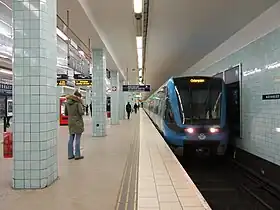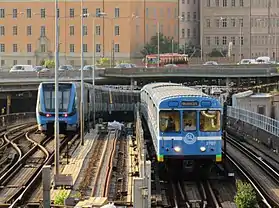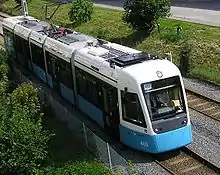Stockholm Metro
The Stockholm Metro (Swedish: Stockholms tunnelbana) is a rapid transit system in Stockholm, Sweden. The first line opened in 1950, and today the system has 100 stations in use,[1] of which 47 are underground and 53 above ground. There are three coloured lines, as shown on the tube maps, which form seven numbered routes with different termini. Routes numbered 17, 18 and 19 (green line), 13 and 14 (red line) and 10 and 11 (blue line) all go through the centre of the city, resulting in a very centralized system. All three lines and seven routes interchange at T-Centralen station. Apart from this, there are three other interchange between lines, at Fridhemsplan, Slussen and Gamla stan stations.
The metro is equipped with ticket gates. Single tickets may be bought in advance, typically in privately owned smaller shops, on the web, or at ticket machines that are available in all underground stations and on several tram, bus, or boat stops. Tickets are also available at the ticket booth by the gates to the metro, or passengers can use contactless payment with any Visa, Mastercard or American Express payment card.[3]
In 2019, the metro carried 462 million passengers, which corresponds to 1.265,9 million in a normal weekday.[4] The 105.7-kilometre-long (65.7 mi) metro system[1] is owned by the Stockholm County Council through the company Storstockholms Lokaltrafik (SL). The operation has been contracted to MTR since 2 November 2009.
The Stockholm metro system has been called 'the world’s longest art gallery',[5] with more than 90 of the network's 100 stations decorated with sculptures, rock formations, mosaics, paintings, installations, engravings and reliefs by over 150 different artists.
History
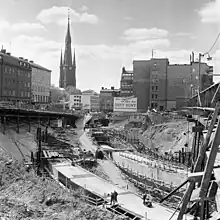
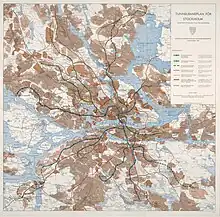
The decision to build a metro was made in 1941, the reason why a metro began to be built in Stockholm was that the congestion on Stockholm's streets had started to become an increasing problem during the first half of the 20th century[6][7]. Something must be done. Cars, buses and trams competed strongly for street space. The rescue from this impending chaos was the metro. Stockholm's politicians were also inspired by large cities such as London, Paris and New York where metros had already been built. Discussions about constructing a metro in Stockholm had started as early as the beginning of the 20th century within the city’s municipal council. However, it wasn’t until 1941, after a lengthy and somewhat heated debate, that the decision to commence construction of the metro was finally made. Post the 1941 decision, Some drama occurred during the planning stage. By the end of 1944, an investigation concluded that Stockholm’s rapidly growing population necessitated a metro with a larger capacity. Consequently, two critical decisions were hastily made to accommodate this increased capacity.
The following years, and in some cases earlier, some routes were built to a near metro standard but operated with trams. These included Kristineberg-Islandstorget, Slussen–Blåsut (including the oldest tunnel Slussen–Skanstull from 1933) and Telefonplan–Hägerstensåsen. The first part of the metro was opened on 1 October 1950, from Slussen to Hökarängen, having been converted from tram to metro operation. In 1951, a second line from Slussen to Stureby was opened (which was also tram operated until then). In 1952, a second system, from Hötorget to the western suburbs was opened. In 1957, the two parts were connected via the Central station (at T-Centralen) and the Old Town (at Gamla stan metro station), forming the Green Line. During the period 1950–1960, the Green Line was extended piece by piece.
The Red Line was opened in 1964, from T-Centralen over Liljeholmen ending in Fruängen and Örnsberg, both in the Southwest.[8] It was extended piece by piece until 1978, when it reached Mörby centrum via a bridge over Stocksundet sea strait. The third and final system, the Blue Line, was opened in 1975, with two lines running northwest from the city center. As the construction requirements have become more strict over the years, newer segments have more tunnels than older ones, and the Blue Line is almost entirely tunnelled. The latest addition to the whole network, Skarpnäck station, was opened in 1994.
Network
Stations
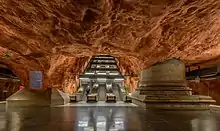
There are 100 stations in use in the Stockholm metro (of which 47 are underground). One station, Kymlinge, was built but never put into use. One station has been taken out of use and demolished. The old surface station at Bagarmossen was demolished and replaced with a new underground station, this being prior to the metro extension to the Skarpnäck metro station.
The Stockholm metro is well known for the decoration of its stations; it has been called the longest art gallery in the world.[9] Several of the stations (especially on the Blue Line) are left with the bedrock exposed, crude and unfinished, or as part of the decorations. At Rissne, an informative fresco about the history of Earth's civilizations runs along both sides of the platform.
Lines
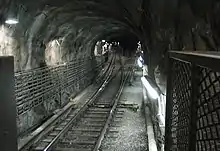
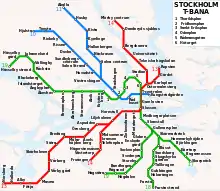
The following details relate to the present network. The designations "Blue line", etc., have only been used since the late 1970s, and officially only since the 1990s. They originated from the fact that the "blue line" tended to operate newer train stock painted blue, while the "Green line" had older stock in the original green livery. There was never any red painted stock, though, but red (or originally orange) was chosen to differentiate this line from the other two networks on route maps.
- The Green line (officially Tunnelbana 1, or "Metro 1") has three routes and 49 stations: 12 underground (nine concrete, three rock) and 37 above ground stations. It is 41.256 kilometres (25.635 mi) long. It was opened on 1 October 1950 (between Slussen and Hökarängen stations) and is used by 451,000 passengers per workday or 146 million per year (2005).
- The Red line (Tunnelbana 2) has two routes and 36 stations: 20 underground (four concrete, 16 rock) and 15 above ground stations. It is 41.238 kilometres (25.624 mi) long (only 18 metres (59 ft) shorter than the Green line), and was opened on 5 April 1964. It is used by 394,000 passengers per workday or 128 million per year (2005).
- The Blue line (Tunnelbana 3) has two routes and 20 stations: 19 underground (all rock) and one elevated station. It is 25.516 kilometres (15.855 mi) long. It was opened on 31 August 1975 and is used by 171,000 passengers per workday or 55 million per year (2005).
Trains operate from 05:00 to 01:00, with extended all night service on Fridays and Saturdays. All lines have trains every 10 minutes during the day, reduced to every 15 minutes in early mornings and late evenings, and every 30 minutes at night. Additional trains during peak hours gives a train every 5–6 minutes on most stations, with 2–3 minutes between trains on the central parts of the network.
The metro contains four interchanges (T-Centralen, Slussen, Gamla Stan and Fridhemsplan) and lacks any kind of circular or partly circular line (although Stockholm has a semi-circular light rail line, Tvärbanan). A wide majority of the metro stations are located in suburbs, but the network is centred on T-Centralen where all trains in the entire network pass.
In the past, there have been additional route numbers in use for trains operated on part of a line, or during peak hours only. For example, route 23 was used for a peak relief train for route 13, which in the 1970s was operated between Sätra and Östermalmstorg and during the 1990s between Norsborg and Mörby Centrum.
| Line | Stretch | Travel time[10] |
Length | Stations (in "innerstan") |
|---|---|---|---|---|
| 10 | Kungsträdgården – Hjulsta | 23 min | 15.1 km (9.4 mi) | 14, (5) |
| 11 | Kungsträdgården – Akalla | 22 min | 15.6 km (9.7 mi) | 12, (5) |
| 13 | Norsborg – Ropsten | 44 min | 26.6 km (16.5 mi) | 25, (10) |
| 14 | Fruängen – Mörby centrum | 33 min | 19.5 km (12.1 mi) | 19, (9) |
| 17 | Skarpnäck – Åkeshov | 43 min | 19.6 km (12.2 mi) | 24, (12) |
| 18 | Farsta strand – Alvik | 37 min | 18.4 km (11.4 mi) | 23, (12) |
| 19 | Hagsätra – Hässelby strand | 55 min | 28.6 km (17.8 mi) | 35, (12) |
| Entire metro network | 108 km (67 mi) | 100, (25) | ||
There is a connection to the main rail network, which is used for deliveries of new trains and some other purposes. In this case trains are pulled by locomotives since the electrical and other standards are different.[11] This connection consists of a track to Tvärbanan at the Globen station and a rail track from the Liljeholmen Tvärbanan station to the Älvsjö railway station.
Network Map
Technology
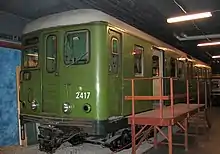
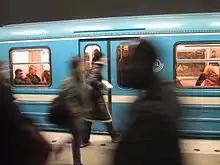
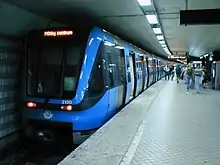

Rolling stock
There are three main types of cars in the Stockholm metro: the newer C20 and C30 stocks, and the older C1–C15 stocks, which are collectively referred to as the Cx stock. A train typically consists of two or three cars of the C20 stock connected in double or triple configuration (six or nine cars), two trainsets of the C30 stock connected in double configuration (8 cars), or six or eight cars of the Cx stock. A full length train—three C20 trainsets, two C30 trainsets, or eight Cx cars—is about 140 metres (460 ft) in length, and takes about 1,250 passengers, of which about 290 to 380 can be seated.[12][13][14][15][16][17] The Blue Line—as well as the Red Line (from Stadion to Mörby Centrum)—was built with longer platforms to allow running trains consisting of ten Cx cars. When the C20 was introduced, it appeared that trains consisting of four C20 cars would not fit completely on these platforms. However ten car Cx trains have only been used in service on the blue line, where except for the platforms at Husby, all platforms are built to fit ten car trains. As most of the red line platforms can only accommodate eight car trains, the ten car trains would only be able to run a distance of 6 stations between Stadion and Mörby Centrum, and therefore ten car trains have not been used in service on the red line.
There are 271 trainsets of the C20 stock, approximately 250 Cx stock trainsets and 96 C30 stock trainsets. The green line only uses C20 stock, and the C20 are used most of the time on the Blue Line and with the C30 stock on the Red Line. However, during rush hours, especially on shortened services, older cars are occasionally seen. Of the older cars the stocks, only C14 are still in use, operating on the blue line. C14 trains may occasionally show up on the red line as well. All trains are based at Hammarby, Högdalen and Vällingby depots on line 17, 18 and 19, Norsborg depot and Nyboda depot on line 13 and 14, and Rissne depot on line 10 and 11.
Historically the metro is converted from a tramway and the older sections were run as tramway for a few years. The naming convention for rolling stock comes from this, where A are motorised trams, B are unmotorised trams (trailers) and C are metro cars.
Former rolling stock (including prototypes)
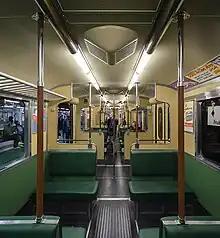
| Class | Introduced | Withdrawn | Notes |
|---|---|---|---|
| C1 | 1950 | 1984 | Some units were rebuilt to C2 and C3 units |
| C2 | 1950 | 1999 | The type with the most train sets produced (348 in total) |
| C3 | 1957 | 1999 | Were not equipped with complete drivers cabs, could only run in the middle of trains |
| C4 | 1960 | 2003 | Were the first units to feature a driver's cab in only one end of the unit |
| C5 | 1963 | 1996 | Silverpilen prototype cars, had an unpainted aluminium exterior. The doors were outlying sliding doors. |
| C6 | 1970 | 2023 | First model with modernised driver's cabin |
| C7 | 1972 | 2004 | Prototype cars |
| C8/C8H | 1974 | 2004 | Four units were rebuilt for service on the Saltsjöbanan in the year 2000 |
| C9 | 1976 | 2009 | |
| C12 | 1977 | 2001 | Were built using old technology from the C1, C2 and C3 types |
| C13/C13H | 1982 | 2003 | Some units were rebuilt into C13H stock in 1995–1997. |
| C14 | 1985 | Still in service | The C14 is the Cx car that has survived the longest. Currently (2023-10-24) there are still 5 trains in service. |
| C14z | 1987 | 1999 | Prototype cars which were used as testbeds for technology that would later be used on the C20 trains. Only 4 cars (a half length train) were ever built. |
| C15 | 1985 | 2023 |
Cx
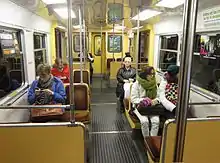
The name Cx collectively refers to all the older types C1–C15. The only cars of the Cx stock still in use are C14. They are 17.32 m (56 ft 10 in) to 17.62 m (57 ft 10 in) in length, 2.8 m (9 ft 2 in) in width, 3.70 m (12 ft 2 in) to 3.78 m (12 ft 5 in) in height, and weigh 29 metric tons. The cars take 48 seated passengers, and 108 to 110 standing passengers. The C14 trains were built in the 1980s.[14]
C20 & C25
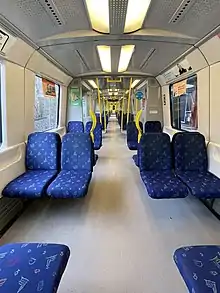
The C20 car is double-articulated, 46.5 metres (152 ft 7 in) in length, 2.9 metres (9 ft 6 in) in width, 3.8 metres (12 ft 6 in) in height, and weighs 67 tonnes (66 long tons; 74 short tons). It uses only four bogies, two under the middle part, and one under each end part of car. The car takes 126 seated passengers, and 288 standing passengers. Three such units normally form a train. The C20 stock cars were built between 1997 and 2004 and first entered service in 1998.[16]
A single prototype car designated C20F stock is in use. Built on Bombardier Transportation's FICAS technology,[18] it has a lighter body, much thinner side walls, and more space compared to the regular C20, by using a sandwich-like composite construction of the body. It also has air-conditioning for passenger area, whereas standard C20 has air-conditioning only for the driver's cab. However only the last 70 C20 units produced (2200-2270) are equipped with air conditioning in the drivers cab. All other C20 units completely lack air conditioning. Therefore units lacking air conditioning are usually placed in the middle of trains and moved to the blue line during the summer, where the air conditioning is the least needed. The C20F weighs 65 tonnes (64 long tons; 72 short tons), other exterior measurements are the same as for the C20. The C20F has the same number of seats as the C20, but has space for 323 standing passengers.[17]
After about 20 years in service (22 years for the oldest cars and 16 years for the youngest cars), the C20 had reached about half its lifetime, and a refurbishment was necessary. The first refurbished train set (three cars) was officially put into service on November 20, 2020, and the refurbishment of all cars is expected to be completed in 2023. These refurbished cars are called C25, and they have, among other things, an upgraded interior similar to the C30.
C30
The C30 is a new articulated train type manufactured by Bombardier Transportation which is delivered since 2018 for use on the red line. The first C30 train entered service on the red line on 11 August 2020.[19] They are formed in semi-permanent four car units with open gangways between cars, and with two bogies under each car. Two such units form a train. Compared to previous stock, the cars have fewer seats arranged in mixed longitudinal/transverse layout for increased capacity, similar to the C1 and refurbished C20 trains.[20] The C30 is the first full Stockholm metro train type to feature air-conditioning in both the passenger compartments and driver's cabs and are expected to cost 5 billion kronor.[21]
Infrastructure and safety

The Stockholm metro runs electrically using a third rail with a nominal operating voltage of 650 V DC on line 13, 14, 17, 18 and 19; and 750 V DC on lines 10 and 11. Traffic in the metro moves on left-hand side, similarly to mainline trains in Sweden. Cars and trams still drove on the left in Sweden when the metro system opened.
The maximum speed is 80 km/h (50 mph) on the Red and Blue Lines, 70 km/h (43 mph) on the Green Line (50 km/h (31 mph) at the platforms). Maximum acceleration and deceleration is 0.8 m/s2. The reason for the lower speed limit on the Green Line is due to tighter curves than on the other lines, because the Green Line was built by cut and cover under streets in the inner city, while the other lines are bored at greater depth. Two safety systems exist on the metro: the older system manufactured by Union Switch & Signal in use on the Red and Blue Lines and a modern automatic train operation (ATO) system in use on the Green Line manufactured by Siemens Mobility.
To allow close-running trains with a high level of safety, the metro uses a continuous signal safety system that sends information continually to the train's safety system. The signal is picked up from the rail tracks through two antennas placed in front of the first wheel axle and compared with data about the train's speed. Automatic braking is triggered if the train exceeds the maximum permitted speed at any time. The driver is given information about the speed limit through a display in the driver's cabin; in C20 stock, and in Cx stock outfitted for operation with the new signal system installed on the Green Line, this is a speedometer with a red maximum speed indicator (needle), while the traditional display in the Cx stock is a set of three lights indicating one of three permitted speeds (high, medium, low). The system allows two trains to come close to each other but prevents collisions occurring at speeds greater than 15 kilometres per hour (9.3 mph). More modern systems also ensure that stop signals are not passed.
Another possibility is automatic train operation, which helps the driver by driving the train automatically. However, the driver still operates the door controls and allows the train to start. ATO is as of 2023 only available on the Green line, where a new signal system was installed in the late-1990s. This signal system, together with the C20 rolling stock, permits the use of ATO. The signalling system on the Red Line was supposed to be replaced with a Communications-based train control (CBTC) system manufactured by Ansaldo STS under a contract awarded by SL in 2010, however SL cancelled said contract in 2017, reportedly after repeated delays in project implementation.[22][23]
Graffiti
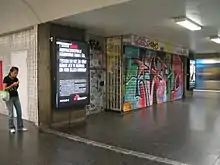
Since the mid-1980s, the Stockholm metro has experienced the presence of graffiti. There was a time when a train adorned with graffiti could continue in service for weeks, and graffiti at stations might have been seen for months, if not years. In recent times, the approach has changed. Trains exhibiting graffiti are promptly removed from service, and any graffiti at stations is typically addressed within a few days. The financial impact of addressing graffiti and vandalism is estimated to be around 100 million SEK annually.[24]
During the 1990s, the Stockholm Transit System (SL) started outsourcing security to private security firms, some of which have been accused of using unlawful methods, such as the use of plainclothes guards and heavy-handed treatment of vandals arrested, and even heavy-handed treatment of ticketless passengers trying to escape. Since 2005, the Stockholm Police have assigned a special task force (Klotterkommissionen) to address these issues. The mainstay among the private security contractors in the fight against graffiti is the Commuter Security Group.
Future
In 2013, it was announced that agreement had been reached on the future of several extensions. Preliminary planning started in 2016[24] and revenue service on the first sections is projected to begin in the mid 2020s.[25] In 2017, another agreement was reached regarding several public transportation projects in Stockholm, including a fifth metro line.[26] The extensions, which are the first in 40 years, will add 18 new metro stations making the total number of stations 118.[27]
Altogether, this amounts to the following new constructions:[28]
- Extension of the Blue Line southwards from Kungsträdgården. There will be a new station at Sofia on Södermalm, after which the line splits with one branch continuing to Nacka (with three new intermediate stations), and the other to new underground platforms at Gullmarsplan after which it will take over the current Green line branch to Hagsätra. The surface-level stations Globen and Enskede gård on the Hagsätra branch will be closed and replaced by a new underground station at Slakthusområdet. This allows higher frequencies on the Green Line branches to Farsta strand and Skarpnäck which are currently limited by the fact that three branches pass the bottleneck at T-Centralen.
- Extension of the Blue Line north-west from Akalla to Barkarby railway station via Barkarbystaden, a new development on the former site of Barkarby Airport.[29]
- Extension of the Green Line from Odenplan via the new development at Hagastaden, Södra Hagalund and ending in Arenastaden (roughly around the vicinity of the Friends Arena and Westfield Mall of Scandinavia), with construction of this segment expected to finish in 2028. [30]
- A new line between Fridhemsplan and Älvsjö via Liljeholmen, Årstaberg, Årstafältet and Östberga.[31]
After the upcoming upgrade of the red line, which includes the construction of a new metro depot in Norsborg and the purchase of a completely new type of metro car, all remaining cars of types C6, C14 and C15 in the metro will disappear, and during the years 2021-2024 will be replaced by the new car type C30.[32]
As of today (October 23, 2023), both C6 and C15 have been taken out of service permanently and only 5 trains of model C14 remain. Four of the remaining C14 trains run in regular traffic, while the fifth and last remaining train is parked between the stations Västra Skogen and Näckrosen as a reserve train.
Stockholm Metro Art Gallery
Stockholm Metro (subway) stations showing many different styles of art and use of materials:
 Hornstull Station (brick tiling suggestive of mock insectoid fossil)
Hornstull Station (brick tiling suggestive of mock insectoid fossil).jpg.webp) Vällingby Station (filigree patterning)
Vällingby Station (filigree patterning) Kungsträdgården Station (wrap-around decor)
Kungsträdgården Station (wrap-around decor) Kungsträdgården Station (fake classical ruins, with lamp post)
Kungsträdgården Station (fake classical ruins, with lamp post)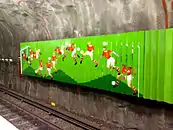 Stadshagen Station (figurative style football image)
Stadshagen Station (figurative style football image).jpg.webp) Kungsträdgården Station (modernistic Art Deco)
Kungsträdgården Station (modernistic Art Deco) Stadion Station (cave rainbow)
Stadion Station (cave rainbow) Karlaplan Station (patterned coloured brick, geometric)
Karlaplan Station (patterned coloured brick, geometric) Karlaplan Station (patterned coloured brick, depth illusion)
Karlaplan Station (patterned coloured brick, depth illusion) Tekniska Hogskolan Station (giant dice with triangular faces)
Tekniska Hogskolan Station (giant dice with triangular faces) Tekniska Hogskolan Station (fixed and fluid forms emphasise straight lines for human artefacts)
Tekniska Hogskolan Station (fixed and fluid forms emphasise straight lines for human artefacts)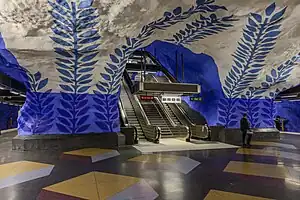 T-Centralen Station (stylised natural forms over depth-illusion flooring)
T-Centralen Station (stylised natural forms over depth-illusion flooring) T-Centralen Station (glazed tiles juxtapose symmetry and asymmetry)
T-Centralen Station (glazed tiles juxtapose symmetry and asymmetry) Slussen Station (perforated painted metal grid mimics traditional framed picture)
Slussen Station (perforated painted metal grid mimics traditional framed picture) Karlaplan Station (plasticised photo-collage, fantasy from real photos)
Karlaplan Station (plasticised photo-collage, fantasy from real photos) Östermalmstorg Station (concrete tunnel wall with graffiti-style reminiscent of prehistoric art)
Östermalmstorg Station (concrete tunnel wall with graffiti-style reminiscent of prehistoric art) Rådmansgatan Station (porcelain tiles printed with reproductions of building designs)
Rådmansgatan Station (porcelain tiles printed with reproductions of building designs) CityTerminalen entrance from T-Central Station (bubble lights and optical illusion of a well)
CityTerminalen entrance from T-Central Station (bubble lights and optical illusion of a well) T-Centralen Chromatic art (after the first escalator)
T-Centralen Chromatic art (after the first escalator)
See also
Notes
- Red and green lines use 650 V
References
- "SL Annual Report 2006" (PDF). Storstockholms Lokaltrafik (SL). 21 June 2007. p. 17. Archived from the original (PDF) on 27 September 2007. Retrieved 21 May 2014.
- "Hållbarhetsredovisning 2017, året i korthet" (in Swedish). MTR Nordic. 2018. Archived from the original on 2 December 2018. Retrieved 2 December 2018.
- "Contactless transit payments launched across Stockholm".
- , p. 67
- "Stockholm Metro: The World's Longest Art Gallery". twistedsifter.com. 7 May 2012.
- "Stockholms tunnelbana". people.kth.se. Retrieved 23 October 2023.
- "20th century", Wikipedia, 7 October 2023, retrieved 23 October 2023
- See "Technical Description of the Stockholm Underground Railway 1964," published by Stockholm's Public Works Department and the Stockholm Passenger Transport Co. At that time, the lines were known as Line 1 and Line 2.
- "Art and architecture in the Metro". Storstockholms Lokaltrafik. Archived from the original on 28 June 2007. Retrieved 14 July 2007.
- Stockholm metro timetables. Storstockholms Lokaltrafik. 2007. 10 Archived 9 April 2008 at the Wayback Machine 11 Archived 9 April 2008 at the Wayback Machine 13 Archived 9 April 2008 at the Wayback Machine 14 Archived 9 April 2008 at the Wayback Machine 17 Archived 9 April 2008 at the Wayback Machine 18 Archived 9 April 2008 at the Wayback Machine 19 Archived 9 April 2008 at the Wayback Machine
- Tunnelbanevagn C30 nu påväg
- "SL class C6". Svenska Spårvägssällskapet. Retrieved 10 July 2008.
- "SL class C9". Svenska Spårvägssällskapet. Retrieved 10 July 2008.
- "SL class C14". Svenska Spårvägssällskapet. Retrieved 10 July 2008.
- "SL class C15". Svenska Spårvägssällskapet. Retrieved 10 July 2008.
- "SL class C20". Svenska Spårvägssällskapet. Retrieved 10 July 2008.
- "SL class C20F". Svenska Spårvägssällskapet. Retrieved 10 July 2008.
- "C20 and FICAS on the Bombardier site". Bombardier Inc.
- "Nu börjar de nya tågen rulla i Stockholms tunnelbana", dn.se, Swedish, accessed on 19 August 2020
- "Stockholm seeks metro car builders". Railway Gazette International. 14 April 2009.
- "Här är nya tunnelbanetåget - premiärtur på röda linjen", svt.se, Swedish, accessed on 19 November 2019
- "Stockholm metro resignalling contract terminated".
- "Stockholm Red Line resignalling contract cancelled". 8 November 2017.
- "Historisk överenskommelse ger stockholmarna ny tunnelbana". Stockholms läns landsting. Archived from the original on 26 November 2013. Retrieved 26 November 2013.
- "The New Metro", sll.se, accessed 7 April 2019
- Sundström, Anders; Gustafsson, Anna (30 March 2017). "Spårsatsning för 30 miljarder ger 100.000 nya bostäder". Dagens Nyheter (in Swedish). Retrieved 1 April 2017.
- Martos Nilsson, Mårten (19 October 2022). "Första nya tunnelbanan i Stockholm på 40 år: 18 nya stationer" [The First New Metro in Stockholm in 40 Years: 18 New Stations]. Arbetet.se (in Swedish). Retrieved 17 January 2023.
- "Nya tunnelbanan", ssl.se, Swedish, accessed 7 April 2019
- "Blå linje till Barkarby", ssl.se, Swedish, accessed 7 April 2019
- "Green line to Arenastaden". 22 May 2023.
- "Historisk satsning på utbyggd kollektivtrafik i länet", sll.se, Swedish, 30 March 2017, accessed 7 April 2019
- vården, Hitta rätt i; resa, Planera din; sjukresor, Färdtjänst och; webbplatsen, Om; nyheter, Prenumerera på; kakor (cookies), Om; Tillgänglighetsredogörelse; jobb, Lediga; Telefon: 08-123 100 00 (28 October 2021). "Nya tunnelbanetåg på Röda linjen". www.regionstockholm.se (in Swedish). Retrieved 22 October 2023.
External links
- Official website (in Swedish)
- Stockholm Metro at UrbanRail.net
- Tunnelbana I Stockholm
- Stockholm Metro MetroMates.com
- Stockholm Metro Map
- Stockholm Metro at public-transport.net

